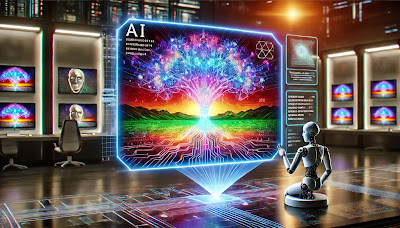Artificial Intelligence (AI) has transformed various aspects of human life, and one of its most fascinating applications is the ability to generate images from text commands. AI-powered image generation tools can create realistic and artistic images simply based on textual descriptions. This advancement has immense potential across multiple industries, including design, entertainment, marketing, and education. In this blog, we will delve into the mechanics behind AI-generated images, the technologies involved, the various applications, and the future possibilities of this innovative field.
Understanding AI Image Generation
AI-generated images rely on machine learning models that have been trained to understand and interpret text descriptions and then generate corresponding visual representations. The process involves several complex steps, including natural language processing (NLP), neural network computations, and image synthesis.
Key Components of AI Image Generation
- Natural Language Processing (NLP): The AI system first processes the text input using NLP techniques to comprehend the meaning and context of the words.
- Deep Learning Models: These models, often built using Generative Adversarial Networks (GANs) or Diffusion Models, learn from vast datasets of images and their descriptions.
- Image Synthesis Techniques: AI employs different image generation techniques, such as diffusion models and GANs, to create images that closely match the given description.
- Rendering and Fine-tuning: Post-processing techniques refine the generated images, enhancing their quality and accuracy.
Technologies Powering AI Image Generation
1. Generative Adversarial Networks (GANs)
GANs consist of two neural networks—the Generator and the Discriminator—that work against each other. The Generator creates images, while the Discriminator evaluates their authenticity. Through continuous iterations, the AI refines its ability to generate high-quality images that appear real.
2. Diffusion Models
Diffusion models gradually refine images from a random noise pattern by following a step-by-step process guided by text descriptions. They have gained popularity for their ability to produce highly detailed and accurate images.
3. Transformer-Based Models
Models like DALL·E and Stable Diffusion use transformer-based architectures to understand textual input and generate images accordingly. These models utilize attention mechanisms to map relationships between words and visual elements.
4. Variational Autoencoders (VAEs)
VAEs help in creating latent representations of images and are often used in combination with other deep learning methods to improve image quality and creativity.
How AI Interprets and Converts Text into Images
The process of converting text into images involves multiple steps, including:
- Text Parsing and Understanding: The AI interprets the text, identifying key objects, actions, styles, and moods.
- Generating a Rough Sketch: Some models create a rough outline of the expected image before refining details.
- Applying Styles and Enhancements: The AI applies predefined styles or inferred artistic elements to match the given description.
- Final Rendering: The image is fine-tuned to produce high-resolution outputs.
Applications of AI-Generated Images
1. Content Creation and Marketing
Businesses use AI-generated images for advertisements, social media content, and digital campaigns. It enables faster and cost-effective content production.
2. Game Development and Animation
AI assists game designers by creating realistic textures, characters, and environments, speeding up the design process.
3. Art and Design
Artists and designers use AI-generated images as inspiration or to create unique digital artworks.
4. Education and Training
AI-generated visuals help in explaining complex concepts in educational materials and training simulations.
5. E-Commerce and Product Visualization
Retailers use AI to generate product mockups and visuals, enhancing online shopping experiences.
Challenges and Limitations
Despite its advancements, AI-generated image technology faces challenges, such as:
- Bias in AI Models: AI models may produce biased or stereotypical images based on training data.
- Ethical Concerns: The potential for misuse, such as generating deepfakes, raises ethical questions.
- High Computational Costs: Generating high-quality images requires significant computing resources.
- Creativity vs. Originality: AI lacks true human creativity and may produce generic or repetitive visuals.
The Future of AI Image Generation
The future of AI-generated images looks promising, with advancements in real-time generation, enhanced creativity, and more user-friendly tools. As AI continues to improve, it will redefine the way we create and interact with visual content.
Conclusion
AI-generated images are revolutionizing creative industries, making it easier than ever to bring ideas to life using just text descriptions. By leveraging deep learning and image synthesis techniques, AI continues to push the boundaries of what’s possible in digital art and design. As technology advances, AI image generation will become even more powerful, shaping the future of creativity and innovation.
Would you like me to add more sections or tailor the blog to a specific audience?

Comments
Post a Comment